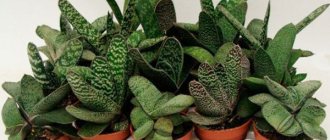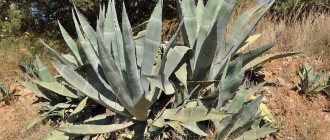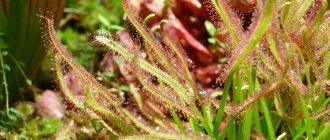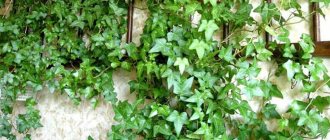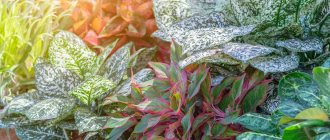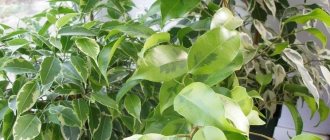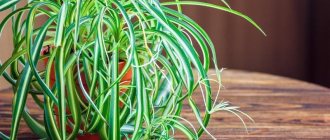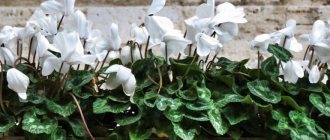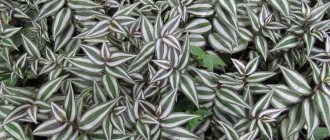Gasteria Armstrong variegata Gasteria is a genus of succulents in the Asphodelaceae , 75 species. It got its name because of the characteristic shape of the flower, reminiscent of a stomach . Together with Aloe and Haworthia, with which it has many similarities, Gasteria is included in the tribe Aloeceae . They grow in the arid regions of South Africa. Gasteria are found on rocky slopes, where, due to their ability to reproduce vegetatively, they form small curtains. Gasterias are perennial leafy herbaceous succulents with thick, fleshy, strap-shaped or tongue-shaped leaves collected in dense rosettes . In young Gasteria, the leaves are arranged in two rows ; with age, the arrangement changes to a spiral one . In some species (for example, G. warty), the two-row arrangement of leaves remains throughout life. The edges of the leaves are usually smooth, the tip is sharp. The surface of the leaves is usually uneven, with characteristic tubercles that form a pattern specific to each species. The flowers are small, tubular, with a characteristic swelling at the base. The difference between Gasteria flowers and Haworthia flowers: in Gasteria the structure of the flowers is tubular, i.e. all the petals are fused, while in Haworthia the petals are only half fused, and their bent petal-like segments are clearly distinguishable at the top. Gasteria flowers are usually red, yellow or orange, located on a long peduncle in an apical one-sided raceme. Like aloe, Gasteria flowers have nectaries that attract insects, although they are self-pollinating. The fruit is a capsule with dust-like seeds, which are spread by the wind, shaking the tall peduncle. But seeds rarely set.
The difficulties of classification are due to the fact that even under natural conditions different types of gasteria easily hybridize with each other. For indoor gasteria obtained by hybridization, the name Gasteria sp. is usually used.
Gasteria warty
The most famous types of gasteria with photos, descriptions, conditions of detention and methods of reproduction
Armstrong's Gasteria (Gasteria armstrongii)
Perennial herbaceous stemless plant. It looks very unique and will attract attention with its very laconic appearance. This is a plant with a small number of very dark, wide, short leaves that are almost spread out on the ground. The leaves of Gasteria Armstrong are tongue-shaped, very thick, 2-4 cm long, 3 cm wide, dark green, wrinkled, with tubercles, arranged in two rows, and in old age - in a spiral in the form of a rosette. The flowers are about 2 cm long, salmon pink. Homeland - South Africa. Rare species in cultivation. It grows very slowly and is the pride of every collector.
Tiny Gasteria bicolor (Gasteria bicolor v. liliputana)
Diseases and pests
Most often, succulents are attacked by aphids, mealybugs and scale insects. Inspect your plant frequently to prevent serious problems caused by these pests.
- When attacked by scale insects , brownish-brown spots appear on the leaves.
- Aphids are very easy to spot on the undersides of leaves. The leaves curl and lose color.
- If a plant is attacked by a mealybug , a sooty coating appears on the leaves. Any methods of getting rid of scale insects are generally ineffective. Most likely, the plant will die.
To combat all pests, you can use soap, alcohol solutions, or ready-made insecticide preparations.
Basically, diseases that occur in gasteria are the result of abundant watering. This is the cause of bacterial and fungal diseases. Here are some signs of a plant infection :
- yellow leaves - excess fertilizer;
- brown spots – exposure to direct sunlight;
- dry brown spots - lack of watering;
- the socket has become sluggish and elongated - insufficient lighting;
- the stem rots in winter - excess watering;
- the inflorescences die before they have time to bloom - the watering regime is disrupted;
- the leaves turned yellow and began to die - the soil was too dry.
But, even if it seems to you that the gasteria has died, do not rush to say goodbye to the plant. The leaves are dying - the root system is alive. Remove the dried leaves, adjust the watering regime, and the gasteria will soon come to life.
Gasteria maculata
Perennial herbaceous plant. Gasteria spotted is one of the large species, reaching a height of 30 cm and above with age, characterized by smooth, dense dark green leaves. The rosettes are two-row, the leaves are succulent, hard, green with light speckles, 5-10 cm in length. The leaves are numerous, biserial, linear or short strap-shaped, up to 20 cm long and 4-5 cm wide, unevenly 3-sided, with a cartilaginous apical spine, dark green, with a large white spot. The flowers are bright red.
Gasteria spotted variegata
Gasteria maculata f. variegata First double-rowed, later curling rosette. The leaves are 5-15 cm long, succulent, hard, bluish-gray with alternating light and dark longitudinal stripes.
Gasteria beautiful
Description and appearance of the plant
Translated from Latin, the plant Gasteria (Gasltron) means “pot-bellied vessel”.
The succulent received this name due to the external resemblance of the swollen perianth to a vessel. Like all desert inhabitants, gasteria accumulates water in its “vessels”. Thick and fleshy leaves vary in color from light to dark green. They vary in length - from 4 to 30 centimeters. White dots and spots are applied to the leaves. The pattern and shade of the leaves depends on the species. Triangular in shape, they form rosettes and are arranged in several rows. The leaf stem is very short.
But the peduncle, on the contrary, can reach 70 centimeters. An adult plant produces a flower stalk with each new row of leaves.
During the flowering period, gasteria pleases its owners with bright flowers of various colors: white, pink, orange, red, green. The racemose inflorescences resemble bells or bottles and last for a month.
Gasteria feels good both as a houseplant and as a garden plant. Can be grown in a group of plants.
Tiny Gasteria (Gasteria lilipuiana)
Other names and subspecies: Gasteria bicolor c. liliputana (tiny) (Gasteria bicolor v. liliputana). Gasteria tiny is a perennial miniature herbaceous stemless plant with numerous shoots extending from the base. The leaves are lanceolate, from 3.5 to 6 cm long, dark green, shiny, with white spots. The leaf arrangement in young plants is two-row, in adults - in a spiral in the form of a basal rosette. The flowers are elegant, about 1.5 cm long, pink at the bottom, green at the top. Homeland - South Africa (Cape Province).
Gasteria glomerata
Gasteria variety Little Varty, or small wart
Succulents of the genus Gasteria: care at home
Let us briefly describe the requirements of succulents of the genus during the growing process.
Priming
To plant Gasteria, prepare a special mixture based on leaf soil, peat and sand (2 to 1 to 1.5). Brick chips of different fractions are also added there. But you don’t have to prepare the composition, but use what is used for growing succulents and cacti. Drainage is a must.
Lighting and location
All types of Gasteria grow well on shaded windowsills. But in summer it is recommended to choose places where there is a sufficiently large amount of lighting. Direct exposure to ultraviolet rays is not the best idea for growing a flower. It is considered optimal to plant crops on window sills facing West or East.
In the summer, it is practiced to grow the crop outside. To do this, find a good place for it, where there are no draft winds and precipitation. If it is not possible to take the plant outside or onto an open balcony, then systematically ventilate the room so that the bush bathes in currents of fresh air.
With the beginning of the autumn period, be sure to think about natural lighting. Fluorescent lamps, which are located 0.5 meters from the succulent, are suitable for this. Lighting duration is at least 8 hours.
Temperature
Temperature indicators are also an important aspect. In summer, the crop needs to set the temperature to +18...25°C. In winter, these indicators decrease significantly - to +6...12°C. Under such conditions, the Gasteria succulent blooms profusely and quite brightly.
Watering
The crop does not need frequent air humidification. But you should water the bushes abundantly, but do not overdo it. The optimal solution is to water immediately after the top layer of soil dries. In autumn and winter, the amount of moisture is reduced.
Information on caring for succulents
How to prepare optimal soil for succulents: the best soil mixtures
What, how and when to fertilize succulents - expert advice
How to water succulents: what gardeners advise
Fertilizer
During the active development of the crop, from May to September, the bush should be fertilized abundantly. The optimal solution is to carry out this procedure once every 14 days. The ideal choice would be to add minerals that are used for succulents or cacti. Please note that with the onset of the so-called “quiet period”, all feeding should be stopped.
Flowering of Gasteria is observed only when all care procedures are performed. Usually this process occurs in spring or summer. Do not forget that succulents that grow on northern windowsills may not please you with beautiful buds.
How to transplant Gasteria
It is recommended to replant the crop every 2 years. This procedure is usually carried out in the summer.
Plants should be transferred into another container, which will be wider in volume. If there are children, you can separate them and grow new bushes. Do not forget that you will definitely need to lay a layer of drainage at the bottom of the pot.
basic information
Gasteria is a member of the Asphodelaceae subfamily, which also includes Aloe and Haworthia. In nature, this perennial plant is found in Central Asia, the Mediterranean and Africa. About 80 species of succulents have already been discovered and studied, but this is not the final number, since wild-growing gasteria of different varieties are capable of interbreeding on their own, due to which new hybrids appear. Naturally, breeders do not stand aside, obtaining original flowers of this species.
To date, the collection of domestic gasteria is represented by 10 species. All of them are compact in size, have thick, tough foliage and bloom in tubular inflorescences. The foliage grows from the root or is located in 2 rows: on a shortened stem in young plants, in adult specimens it creates a spiral rosette.
Gasteria is a flowering succulent; in spring it produces thin peduncles covered with pinkish or scarlet flowers of an original shape, reminiscent of an amphora, hanging on short stems.
Gasterias take root well at home and require minimal care, which is why they are loved by many gardeners.
Reproduction
There are three types of reproduction of Gasteria.
Gasteria is very rich in children , this is the easiest way of reproduction. At the time of transplantation, the children are separated from the mother's outlet and immediately planted in suitable-sized pots in soil for cacti or other soil suitable for succulents. Water periodically, avoiding excess moisture.
When propagating by leaf cuttings, select a healthy, strong leaf, carefully cut it and dry it for several days. Then the leaf is planted in soil or sand for rooting. You need to water it after about 25-30 days, when young roots appear.
To propagate by leaf, it must be cut, dried for two to three days, and then planted in the ground or sand. Watering begins no earlier than a month after the formation of new roots.
The seeds ripen in mid-summer. Wet sand is prepared for the seeds, where they are scattered. There is no need to pour on top. Next you need to create a greenhouse. To do this, cover the container with seedlings with glass or polyethylene and maintain a temperature of +15...+20 degrees. Do not forget to provide ventilation and spraying for the seeds. Seedlings germinate in 1.5-2 months. The sprouted babies are placed in pots.
Gasteria flower and its photo
Gasteria is a large (about 60 species) genus of African plants, which are characterized by the formation of rosettes of leaves. Small flowers on tall branched peduncles decorate them only slightly.
Gasterias are as unpretentious as aloe, they can be kept in the shade and in the sun.
Those who believe that gasteria are not interesting for collectors are very mistaken - they simply have not seen real collections. It turns out that such collections exist, and they are extremely interesting and rich. Among the gasteria there are unusual species and, surprisingly, many ornamental cultivars.
Look how beautiful the gasteria flower is in these photos:
Diagnosis of White piedra (nodular trichosporia):
The diagnosis is easily established based on the uniqueness of the clinical symptoms. In difficult cases, the diagnosis can be confirmed by microscopic and cultural studies. In hair nodules, microscopy reveals a wide (4-6 µm) mycelium, breaking up into oval, round and rectangular arthrospores, arranged mosaically or in clusters. On Sabouraud's medium, grayish-yellow, dark cream, and black colonies are formed. Piedra is differentiated from the so-called false piedra, caused by bacteria that form porous cream-colored colonies with a scalloped border along the periphery on Sabouraud's medium, pediculosis.
The main rules for replanting indoor plants
It is a known fact that proper care of indoor plants extends their lifespan.
Pilea flower: home care, photos and types, propagation and replanting
One of the factors of proper care is replanting into a larger pot with fresh soil. The intervals between transplants are different for all plants, but still in this article we will try to systematize this data and consider the basic principles and rules of correct transplantation.
Most perennial plants need to be replanted once a year or every two years; some slow-growing plants need to be replanted once every three years.
- Complete transplant. During such a transplant, all the soil is replaced, making sure to clear the roots of the plants from the old soil.
- Partial transplant. For such a transplant, there is no need to disturb the roots; it is enough to replace the soil around the rhizome.
- Replacing the top layer. This type of replanting is suitable for situations where it is enough to “sprinkle” the bare root of the plant or in cases where it is necessary to remove the top layer and fill the vacant space with fresh soil.
Growing using the example of Gasteria warty
Gasteria warty is a very popular species of this genus, and we can often find it in home collections of ornamental plants. Plant lovers appreciate it for its decorative properties, as well as for its low growing requirements.
Structure
A small succulent with fleshy, dark green leaves with numerous lighter nodules that reflect the name of the plant species. The sharp leaves reach several centimeters in length. During flowering, gasteria can reach several tens of centimeters in height, due to the tall shoot of the inflorescence ending in a cluster of tubular pinkish flowers with a green tip.
On a note …
Another name for Gasteria verrucosa is, among others, papillary tongue.
Origin
The natural habitats of Gasteria are in South Africa.
Location in the house
Gasteria is an undemanding plant, so it will grow both in a sunny place and in a less sunny part of the apartment, preferring bright places to sunny ones. Remember that in summer, if exposed to sunlight, the leaves can burn, so if necessary, protect from direct sun.
If you have a bright balcony, in the summer you can take the plants out into the fresh air, which will have a positive effect on the development of gasteria. If gasteria is placed outside, it is necessary to provide shelter, shading (50-60%) and not expose the plants to direct contact with the sun and rain.
Gasteria flowers
Substrate
Like other succulents, Gasteria requires a highly permeable substrate. A sandy loam substrate with the addition of peat is well suited, to which you can additionally add clay and a mineral base (zeolite).
If you decide to prepare the substrate yourself, remember that the part consisting of minerals should be approximately 2/3 of the total amount, and the humus part should be approximately 1/3. You can take compost as the humus part, and the rest: vermiculite, zeolite, perlite, gravel, etc.
Transfer
The root system of Gasteria is shallow, so there is no need to buy deep pots; it is better to buy smaller but wider pots, which is justified by the fact that Gasteria produces shoots adjacent to the mother plant, which over time form dense “colonies”.
We replant every few years, in early spring, if necessary at another time.
When replanting, remember about drainage, which, in combination with a permeable substrate, will even better protect our plants from overwatering.
Temperature
Does not place any special requirements on room temperature. Grows well at room temperature. In winter the plant goes into a dormant period, so we provide a lower temperature of around 10°C (4-7°C-15°C).
Watering
During the growing season, we do not water gasteria too often, always monitoring the substrate, which should not be wet! In summer, gasteria should be watered more often, about once a week, during the rest of the growing season less often: every two weeks, and in winter, during dormancy, at lower temperatures, watering should be kept to a minimum, so during wintering gasteria are watered very rarely, once at 2-3 months.
Always carefully monitor the substrate's moisture during this period and water when the substrate is almost completely dry. The transition period between the dormant period and the growing season, as well as the growing season and the dormant period, should be characterized by a systematic reduction or increase in the frequency of watering.
Fertilizer
During the growing season, gasteria should be watered with fertilizers intended for cacti and other succulents approximately every two weeks.
Other requirements
Gasteria does not like drafts, but loves fresh air, so if we do not take the plants to the balcony in the summer, do not forget to ventilate the room where our plant is located.
Types and varieties of shefflera with photos and names
As a rule, the following types of shefflera can be found at home:
Schefflera actinophylla
The most popular type. Schefflera actinophylla is also called the "octopus tree". In nature, its growth reaches 15 m. Moreover, the plant is considered a semi-epiphyte, living on other trees. The length of the inflorescences reaches 2 m and includes many burgundy flowers rich in nectar. Many animals and birds feed on the fruits of this shefflera. Sometimes such trees can grow significantly, turning into an invader weed.
In potted conditions, such a shefflera can grow up to 3 m. Its growth rate is very high. Each leaf umbrella includes up to 16 green leaves. Their length reaches 15 cm, and their width is about 5 cm. The ends of the lobes are slightly blunted.
Star-leaved - sometimes called the radiate-leaved species. It is distinguished by reddish shoots and shiny leaf blades. The leaves can be olive, bright green or golden in color.
Schefflera digitata
More compact appearance with dissected leaf blades. Each lobe of Schefflera digitata has a pointed end. The color of the sheet can be monochromatic or has tints. The peculiarity of the species is the wavy edges of the leaves and bright contrasting veins.
Schefflera arboricola (Schefflera arboricola)
The size of this species rarely exceeds 1 m. As the branches of such schefflera grow, they become woody. Careful pruning allows the tree to form a beautiful crown with dark green foliage. Schefflera arboricola is especially valued for its high resistance to fungal infections and pests.
Variegated - under this name we combine schefflers with beautiful spotted leaves. They are painted a rich green color and complemented by cream or yellow spots. Such plants are not found so often in home floriculture, but are considered one of the most elegant.
Schefflera octophylla (Schefflera octophylla)
The species is considered quite rare. The young foliage of this shefflera is olive-colored and has prominent veins. Older leaves become light green in color. Each umbrella includes up to 12 lobes. The leaf blades of Schefflera octophylla are shiny on the outside and matte on the inside.
Schefflera Louisiana
A species characterized by spectacular foliage of a juicy shade. In Schefflera Louisiana they are covered with lighter spots.
Among the most popular plant varieties:
- Bianca is a variety notable for its original foliage color. Such a plant can bloom only in greenhouse conditions. Its height in this case reaches 2.5 m, while in nature such a shefflera sometimes grows up to 20 m.
- Janine is a small-leaved variety, the leaf blades of which have a blurry color and include several shades of cream and green. The edges of the foliage are feathery and rounded.
- Nora - the foliage of this variety is medium in size and colored a light shade of green with neat splashes of yellow. There are serrations on the edges of the leaves. Thanks to pruning, such a plant can be formed into a lush tree.
- Gerda - refers to tree varieties. The foliage is usually green in color, but sometimes has large areas of yellow.
- Melanie - this variety does not grow too much in width, so it is considered very compact.
- Gold Capella is a variegated variety with a straight trunk, which is why from the outside it may look a little like a palm tree. When grown in pots, the height of such a plant can reach up to 1.2 m.
- Amate is a beautiful variety with glossy leaf blades. Considered resistant to pests and diseases. Unlike most, Scheffler is considered shade-tolerant.
Decorative foliage plants Indoor plants
Reproduction by seeds or separation of children
Gasteria can be propagated in two ways. Both have some features that are worth considering.
Seeds
Growing from seeds takes some time. It is necessary to prepare suitable and loose soil. The soil is moistened and seeds are sprinkled on top. Cover the container with glass or film and leave in a warm place. The soil is periodically moistened.
After a couple of months, the first shoots will appear. When the plant already has 4 leaves, it can be transplanted into a separate pot in a permanent place.
Children's department
This method is much simpler and faster. An adult plant often produces small children nearby. They are separated and dug up. Together with the soil, the sprouts are placed in new pots and watered well. After some time, the plant will begin to develop and grow.
Gasteria can be propagated using leaves. Separate one from an adult flower, sprinkle the cut with crushed coal and dry it a little. After a couple of days, place it in moist soil. After about a month, the first roots will appear and the sprout can be transplanted to a permanent place. The succulent grows for a very long time.
Important! The choice of reproduction method depends on the preferences and capabilities of the person.
Gasteria has many types

